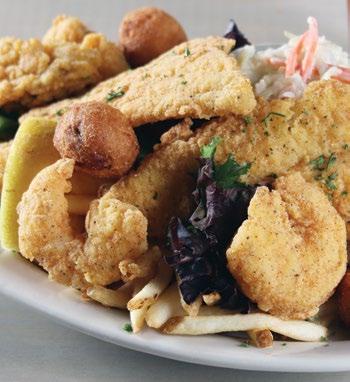
4 minute read
Adventures in Herb Gardening
by Mimi Greenwood Knight
FOR ME, THE PERFECT SUMMER MORNING looks something like this: waking at the crack of dawn, pouring myself a cup of coffee and wandering out into the vegetable garden to gather whatever I can. Everything’s dewy from the night before, and the garden is mercifully still in shade. I fill my basket with whatever’s ready, take it inside and cook some up for breakfast with a free-range egg or two. Eggplant, okra, bell pepper, asparagus, maybe a melon, each day’s a little different. And the excitement of remembering I started it all from seed, just weeks ago, never gets old. It’s a summertime miracle every morning.
I’ve only been gardening a few years, and except for a pot of mint or some rosemary here and there, I hadn’t really tried my hand at herbs. It was time to remedy that. So, for Christmas last year, I asked Santa for built-in herb boxes across the back of our deck. A foot wide and 22-feet long, they’re the ultimate in aromatherapy. And what could be better than cooking with herbs I just picked? Once the boxes were constructed and filled with soil, I enlisted the help of “The Herb Lady” who came from Ponchatoula with a trunkful of annual and perennial herbs and loads of great advice. She gave me a quick tutorial on each herb as we planted it and an invitation to request whatever I wanted her to start for me for next season.

For the first couple of weeks, all I did was admire—and smell—my herbs. The Herb Lady told me the more I used them, the better they’d grow, but I couldn’t bring myself to start whacking away. I began gingerly “borrowing” a little fresh mint for mojitos; cilantro, fennel, and chervil for green salads; and rosemary, thyme, and sage for marinades. I gingerly snipped and pinched strategically in places I thought it wouldn’t show. But guess what? It all came back—in spades. The Herb Lady was right. This stuff wants to be used.
I’m getting braver now, and I’m learning a lot. Here’s a quick rundown of what I’m learning. Begin by planting the herbs you like and use the most. Rosemary, oregano and thyme are pretty much foolproof to grow. So are chives, basil, parsley, and cilantro. And mint is crazy hearty. But be warned. If you give mint an inch, it’ll take a mile. Best to contain it in pots.
Some herbs are perennial (sage, thyme, rosemary, chives, mint). Some will need to be replanted annually (basil, dill, cilantro, parsley). Some grow in summer (mint, chives, dill, tarragon, and my favorite, basil) and some in winter (parsley, cilantro, chamomile, dill, oregano, borage, chives, garlic). Many are also good companion plants. Chives in your rose bed, for instance, can ward off the nemesis Japanese beetle, reduce black spot and enhance the growth of your roses. Dill attracts beneficial insects to the garden, including ladybugs, butterflies, honey bees and wasps. And certain herbs deter fleas, ticks, ants, mosquitos and other pests (catnip, lavender, garlic, chives, rosemary, basil, and mint).

Most herbs look lovely growing in pots or as edible borders in your flowerbed. But however you choose to grow them, they’ll do best with six to eight hours of sun, rich soil and good drainage. While growing from seed is cheaper, there’s no shame in your game if you buy established plants from Whole Foods or Fresh Market; Home Depot or Lowe’s; a local nursery or feed and seed; or farmer’s market. Once they’ve taken root and started growing, the more you snip and use them, the heartier they’ll be—really.
I’m also having fun preserving some of my herbs to share with friends. Oregano, rosemary, thyme, bay and dill all dry beautifully because they don’t have a high moisture content to begin with. Even dried, they’ll be fresher than the dry herbs you buy at the store. To dry your herbs, harvest them early in the day, wash them, and pat them dry. Place them on a baking sheet lined with parchment paper in a 150-degree oven with the door slightly ajar for about four hours. (Oh, the aroma!) Or you can hang them to dry or dry them in a dehydrator.
You can also have fun preserving your herbs in recipes such as pesto, herb vinegar, or herb butter; all make lovely gifts. Or freeze them on a cookie sheet to store in airtight containers or in silicon ice cube trays with ¼ herb to ¾ olive oil.
Whether you grow them in pots, raised beds, or in the ground, indoors or out, and whether you use them fresh, dried, or frozen, there’s nothing like your very own herbs to make your recipes really sing. And growing them can be a source of health, pride, aromatherapy and beauty.
Is Fresh Always Best?

Fresh herbs aren’t always your best choice. Unless you’re growing them yourself, they can cost a fortune at the grocery store. You’ll likely use a pinch in your recipe. Then the rest will spoil in the produce drawer. Of course, fresh herbs are preferable if you’re making a green salad or pasta salad. And leafy herbs like parsley, tarragon, and chives are better fresh. But if you’re making a sauce, stew, or soup that will cook a while, dried herbs are fine. In fact, oregano, marjoram, thyme, rosemary, bay leaf, curry leaf, and fennel seed are actually better when dry. Dried herbs do lose potency over time, though. So be sure to toss them and buy more, after a year.










